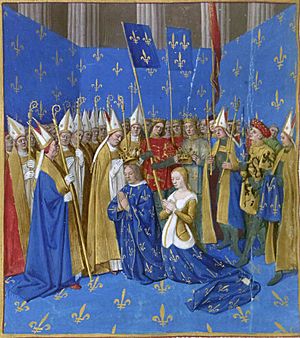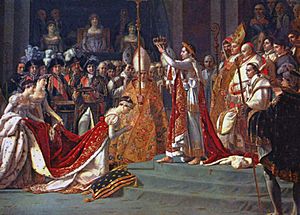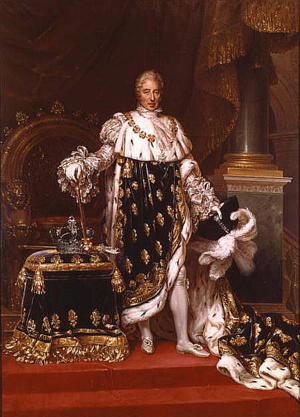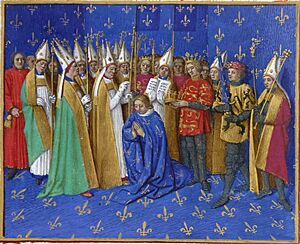Coronation of the French monarch facts for kids

Becoming the King of France was a very special event. It was made official with a ceremony at Reims Cathedral. During this ceremony, the king would use important items like the Crown of Charlemagne. Later, a new king was recognized right after the old one died. People would shout, "The King is dead, long live the King!"
The most important part of the French ceremony was not just the coronation (placing the crown). It was the Sacre, which means the anointing or blessing of the king with holy oil. This tradition started with King Pepin the Short. He was anointed in Soissons in 752 to make his new family's rule official. Later, Pope Stephen II anointed Pepin again in 754. This was the first time a Pope performed the anointing.
This anointing reminded people of King Clovis I's baptism in Reims in 496 or 499. The ceremony was moved to Reims in 816. It included using the Holy Ampulla, a special glass vial found in 869. This vial held a holy balm. People believed a dove from the Holy Spirit brought this balm. Because of this, French kings claimed their power came directly from God. After the anointing, the king's shirt and gloves were usually burned. This showed respect for the miraculous oil. However, King Louis XV's shirt was not burned. It was given to the King of Portugal, John V. Today, you can see it at the National Palace of Mafra.
Special items used in the coronation are called regalia. These included the throne and sceptre of Dagobert I. Also, the crown and sword of Charlemagne were used. These items were kept in the Basilica of Saint-Denis near Paris. The Holy Ampulla and a special Chalice were kept in Reims. Some of these items are still there today. Others are in the Louvre and other museums in Paris.
The Holy Ampulla was kept in a fancy gold box covered with jewels. In the middle was a white dove, representing the Holy Spirit. The Ampulla itself formed the dove's body. The abbot (head) of the Abbey of Saint-Remi would carry it. He walked barefoot in a procession to the cathedral. There, he gave the relic to the Archbishop of Reims. All French kings were anointed with this same oil, mixed with another holy oil called chrism. This happened before their coronation.
French queens were also crowned. This happened either with their husband at Reims or alone at Sainte-Chapelle or the Basilica of Saint-Denis.
Contents
Who Participated in the Coronation?
The Archbishop of Reims was in charge of crowning the king. Four other bishops helped him. The Bishop of Langres and the Reims Cathedral Chapter also assisted.
Here were the six bishops and their roles:
- The Archbishop of Reims anointed and crowned the king.
- The Bishop of Laon carried the holy ampulla.
- The Bishop of Langres carried the scepter.
- The Bishop of Beauvais carried the royal mantle (a special cloak).
- The Bishop of Chalons carried the royal ring.
- The Bishop of Noyon carried the belt.
Also present were the Abbot of Saint-Remi Abbey, who guarded the holy ampulla. The Abbot of Saint-Denis Abbey guarded other royal items.
Important noblemen called Peers also took part. They were first mentioned in 1203. Their first recorded participation was at the coronation of Philip V of France in 1317. There were six church peers (the bishops mentioned above) and six lay peers (powerful nobles).
In order of importance, the six lay peers were:
- The Duke of Burgundy carried the royal crown. He also gave the king his sword and the order of chivalry.
- The Duke of Normandy carried the first square banner.
- The Duke of Aquitaine (or Guyenne) carried the second square banner.
- The Count of Toulouse carried the spurs.
- The Count of Flanders carried the royal sword.
- The Count of Champagne presented the king with the war flag.
The church peerages lasted forever. But the lay peerages often changed. For example, Normandy became part of the French crown in 1204. Because of this, royal princes and other high-ranking nobles often stood in for the original lay peers.
Where Did Coronations Happen?
After the first two Capetian kings were crowned elsewhere, most ceremonies took place at Reims Cathedral. This started in 1027.
However, there were a few exceptions:
- Louis VI was crowned on August 3, 1108, at Orléans Cathedral. He was anointed by the Archbishop of Sens. Louis feared his half-brother might stop him from reaching Reims. The Archbishop of Reims argued against this, but the king's choice was final.
- John the Posthumous was never crowned. He was king from birth but died just a few days later.
- Henry of Navarre was crowned King of France on February 27, 1594, at Chartres Cathedral. His enemies held Reims at that time.
- After the French Revolution, Louis XVIII chose not to have a coronation. But his successor, Charles X, brought back the ceremony at Reims. He was the last king to be anointed there.
On December 16, 1431, Henry VI of England was crowned King of France at Notre Dame de Paris. This was an attempt to challenge the coronation of his rival, Charles VII of France, who had been crowned at Reims in 1429.
The French Sacre from 1364 to 1825
The French coronation ceremony changed over time. In the 14th century, it went back to older French traditions. But it also kept parts of the Roman ceremony. This made the final version of the ritual very long.
The night before his Sacre, the king stayed at the Palace of Tau. In the morning, clergy and officials helped him get ready. The king then chose nobles to be "Hostages" for the Sainte Ampoule. The clergy also promised to return the Sainte Ampoule to the Abbey of St. Remi after the ceremony.
The king entered Reims Cathedral as prayers were sung. The Abbot and monks of the Abbey of Saint-Remi brought the Sainte Ampoule in a special box. The Archbishop of Reims and other bishops promised to return it. Everyone bowed respectfully as it passed.
The coronation began with the bishops asking that the Church's rights be protected. The king agreed and took an oath. In the Bourbon era, this oath was taken on the Reims Gospel. Then, the king was recognized by the people. A hymn called "Te Deum" was sung. The king put on special boots and spurs. He was given the Coronation Sword, Joyeuse. The king then took off his outer clothes. Special openings in his silk shirt were opened to show his chest, back, and arm joints. A small piece of the holy oil from the Sainte Ampoule was mixed with Chrism on a plate.
The king knelt while a special prayer, the Litany of the Saints, was chanted. The Archbishop then said a long prayer of consecration. This prayer asked God to bless the king and help him rule justly. The Archbishop then anointed the king with the Chrism. He made a cross on the king's head, chest, shoulders, and arms. Each time, he said, "I anoint thee king with holy oil in the name of the Father, and of the Son, and of the Holy Spirit." Everyone responded, "Amen." While this happened, the choir sang a special song. The Archbishop then said more prayers, asking God to guide the king.
After the anointing, the king's shirt was closed. He then put on a special blue velvet tunic, dalmatic, and royal mantle. These were decorated with gold fleurs-de-lys (lily symbols). These clothes represented different church roles. The king knelt again, and the Archbishop anointed the palms of his hands. He said, "Be those hands anointed with sanctified oil, as kings and prophets were anointed..."
Next, the royal gloves were blessed and placed on the king's hands. The ring was blessed and placed on his hand. The scepter (a staff showing kingly power) was placed in his right hand. The Hand of Justice (a symbol of fairness) was placed in his left hand. Then, the peers came forward to help. The Archbishop took the Crown of Charlemagne from the altar. He said, "Receive this crown..." and placed it on the king's head. The other eleven peers touched it with their hands. After the crowning, the Archbishop said more blessings.
Finally, the lay peers lifted the king onto his throne. The Archbishop said, "Stand fast and hold firm the place..." The choir sang a song about justice and mercy. The Archbishop then kissed the king and said, "May the king live forever." The peers and all the people cheered, accepting him as their new king.
A special Mass (church service) was then held. The king received Holy Communion (bread and wine). At the end of the Mass, the Oriflamme (a sacred battle flag) was blessed.
The king's journey back to Paris and his grand entry into the capital completed the ceremony.
Crowning the Next King
In the Middle Ages, some French kings crowned their sons while they were still alive. This was done to avoid arguments over who would be king next. These sons were called "junior kings." But they had little power and were not counted in the list of monarchs. Nobles did not like this custom. It meant they had fewer chances to gain power during a fight over who would be king.
The last French prince to be crowned while his father was alive was Philip II of France. This practice eventually stopped in all kingdoms. Rules about the oldest son inheriting the throne became stronger.
Imperial Ceremony

During the First French Empire, Emperor Napoleon I and Empress Josephine had a very grand coronation in December 1804. Pope Pius VII led the ceremony at Notre Dame Cathedral in Paris. The Pope and church leaders entered first, followed by Napoleon and Josephine. Their special items, the Imperial Regalia, were carried before them.
The Pope blessed the regalia. Napoleon was then anointed three times on his head and hands. The most famous part was when Napoleon took the crown and placed it on his own head. He then crowned his wife, Josephine, who knelt before him. Six months later, Napoleon was crowned King of Italy in Milan.
Emperor Napoleon III chose not to have a coronation. However, for a big exhibition in 1855, the Crown of Napoleon III was made. It was later destroyed. A smaller crown was made for his wife, Empress Eugenie. This crown is still owned by the French government.
When the Ceremony Ended

The last French royal coronation was for Charles X in 1825. It took place at Reims Cathedral. Charles's decision to be crowned was not popular with the public. He was overthrown in a revolution in 1830. His successor, Louis Philippe I, chose not to have a coronation.
After 1875, the French government broke up and sold most of the French Crown Jewels. They hoped this would stop anyone from trying to bring back the monarchy.
See also
- Coronation of the Holy Roman Emperor
- Coronation of the British monarch


